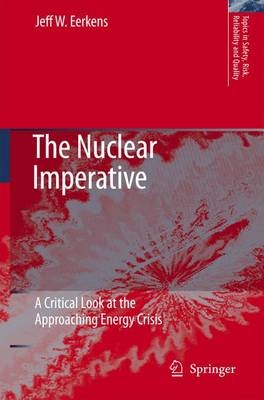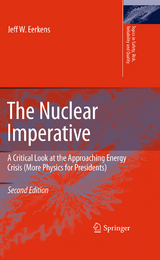
The Nuclear Imperative
Springer-Verlag New York Inc.
978-1-4020-4930-9 (ISBN)
- Titel erscheint in neuer Auflage
- Artikel merken
In this well documented global wake-up call, nuclear physicist Jeff Eerkens explores remedies for the impending energy crisis, when oil and natural gas are depleted. Because burning coal worsens the problem ofglobal warming, alternate energy sources must be instituted. The Nuclear Imperative demonstrates with scientific documentation that solar, wind, and biomass power, while helpful, are incapable of supplying and sustaining the enormous quantities of electricity and heat needed for manufacturing portable synthetic fuels (synfuels) to replace our current use of fossil fuels. Instead, it offers a fresh look at uranium-produced energy as the optimal affordable solution. Long misunderstood and irrationally feared because of antiquated beliefs by the general public, modern nuclear power generation is safer, cleaner, and essential for solving the future energy shortfall. Using a detailed, scientific approach to dispel common myths, The Nuclear Imperative shows that uranium fission power is available for 1,500 years as a prime energy source to provide all the world's energy needs.
Because it takes ten to twenty years to design, test, and build new synfuel-producing reactors and new engines powered by new synfuels, action must be taken soon to prevent a catastrophy thirty years from now when oil runs out.
PREFACE; 1. INTRODUCTION; 1.1 Declaration of Independence from Oil; 1.2 Means and Risks to Overcome the Pending No-Oil Crisis; 1.2.1 Risks in the Nuclear Millennium Option; 1.2.2 Risks of the Renewables-Only Option; 1.2.3 The Coal-Burning Option; 1.2.4 The Do-Nothing Option; 1.2.5 Conclusions based on the Risk Assessment of Options (1), (2), (3), and (4); 1.3 Organization of the Book; 2. NUCLEAR FACTS AND FABLES; 3. ENERGY CONSUMPTION AND ENERGY RESOURCES ON PLANET EARTH; 3.1 Definition of Energy and Units for Energy and Power; 3.2 Amounts and Forms of Energy Consumed by Man; 3.3 Limitations of "Renewable" Energy; 3.4 Brief History of Energy; 3.5 Summary of Primary Energy Resources; 4. TECHNOLOGIES FOR PROPELLING CARS, TRUCKS, TRAINS, SHIPS, AIRCRAFT; 4.1 Review of Portable Fuels and Other Portable Energy Carriers; 4.1.1 Portable Synfuels; 4.1.2 Electric Storage Batteries; 4.1.3 Flywheel Energy Storage (Mechanical Batteries); 4.2 Vehicle Propulsion Engines; 4.2.1 Internal Combustion Engines (ICEs); 4.2.2 Electrochemical Fuel-Cell Engines (FCEs); 4.3 Steam Engines; 5. ELECTRIC POWER GENERATION TECHNOLOGY; 5.1 Nuclear Power Reactors; 5.1.1 Basic Design and Operation of a Reactor; 5.1.2 Breeder Reactors; 5.1.3 Nuclear Reactors versus Nuclear Bombs; 5.2 The Uranium Fuel Cycle and Environmental Impacts; 5.2. 1 Uranium Enrichment; 5.2.2 Fuel (Re-) Processing; 5.2.3 Final Disposal of Radiowaste; 5.3 Nuclear Fusion; 6. SAFETY CONSIDERATIONS IN NUCLEAR OPERATIONS; 6.1 Nature of Nuclear Radiation; 6.2 Biological Effects of Nuclear Radiation; 6.3 Radiation Dose Measurements and Tolerable Exposures; 6.4 Radiation Protection in Reactor Operations; 6.5 Mishaps and Malfunctions in Reactor Operations; 6.6 Nuclear Criticality Accidents; 7. NUCLEAR WEAPON CONTROLS AND NON-PROLIFERATION; 7.1 The Nuclear Age and World Realities; 7.2 Safeguards against Terrorists; 7.3 The Non-Proliferation Treaty (NPT) and IAEA; 8. CONCLUSIONS, ACTION ITEMS, AND PREDICTIONS; ANNOTATED BIBLIOGRAPHY; ACKNOWLEDGMENTS; SHORT BIOGRAPHY OF THE AUTHOR; ABBREVIATIONS; CHEMICAL SYMBOLS OF SELECTED ELEMENTS AND ISOTOPES; INTERNATIONAL MKS UNITS AND PREFIXES; INDEX
| Erscheint lt. Verlag | 1.9.2006 |
|---|---|
| Reihe/Serie | Topics in Safety, Risk, Reliability and Quality ; v. 11 |
| Zusatzinfo | Illustrations |
| Verlagsort | New York, NY |
| Sprache | englisch |
| Maße | 160 x 240 mm |
| Gewicht | 438 g |
| Einbandart | gebunden |
| Themenwelt | Naturwissenschaften ► Biologie ► Ökologie / Naturschutz |
| Technik ► Elektrotechnik / Energietechnik | |
| ISBN-10 | 1-4020-4930-7 / 1402049307 |
| ISBN-13 | 978-1-4020-4930-9 / 9781402049309 |
| Zustand | Neuware |
| Haben Sie eine Frage zum Produkt? |
aus dem Bereich



